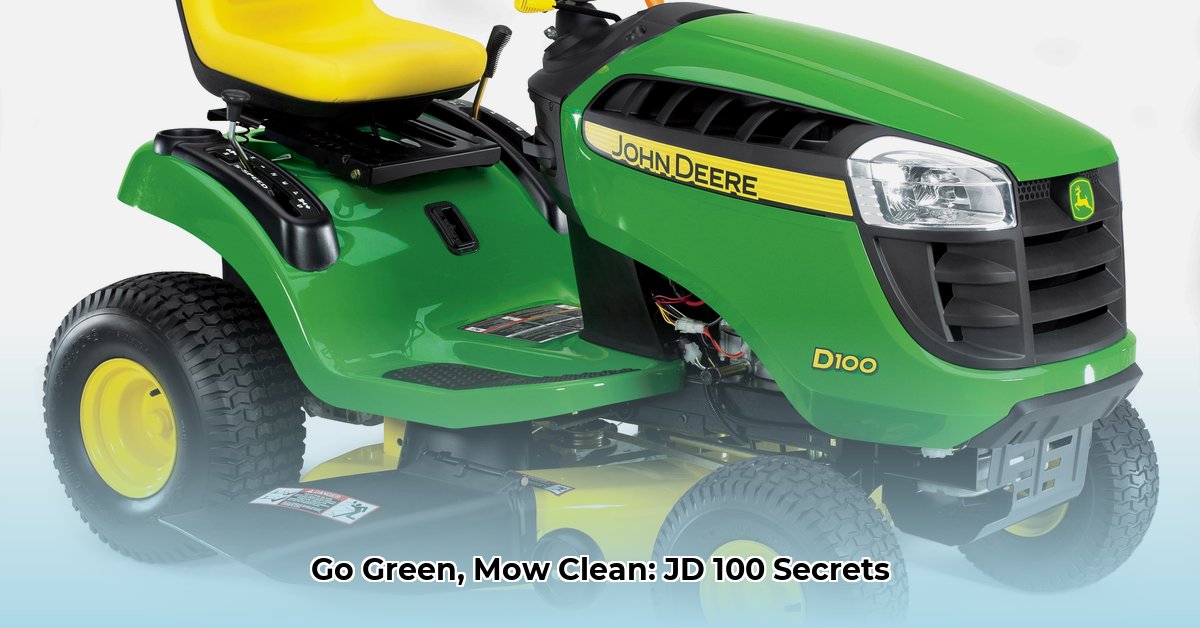
Is the John Deere 100 series lawn tractor truly an environmentally friendly choice? The answer is nuanced, depending on several factors beyond just fuel efficiency. This guide delves into the JD 100's sustainability aspects, offering actionable advice for eco-conscious mowing. For information on maintaining your engine, check out this guide on air filter replacement.
Fuel Efficiency and Operational Considerations
The JD 100 often boasts V-twin engines known for better fuel efficiency than comparable single-cylinder engines. While exact fuel consumption data for the JD 100 isn't currently available, the sealed fuel cap minimizes fuel spills and emissions. Easy oil changes further reduce maintenance-related environmental impact. However, to get a truly comprehensive picture, we need detailed fuel consumption figures and a complete Life Cycle Assessment (LCA). How much fuel does it actually use per hour of operation under various conditions? This information is crucial for a complete environmental evaluation.
User-Friendliness: A Key Sustainability Factor
Intuitive operation is a sustainability asset. The JD 100's hydrostatic transmission, comfortable seat, and user-friendly controls reduce operator fatigue and errors. This translates to less wasted time, fuel, and ultimately, a smaller environmental footprint. Efficiency is heightened by employing optimal mowing techniques.
Optimizing Mowing Practices for Sustainability
Following these steps maximizes your JD 100's efficiency and minimizes environmental impact:
Sharp Blades: Dull blades force the engine to work harder, consuming more fuel. Sharpen blades regularly—a crucial step often overlooked.
Appropriate Mowing Height: Cutting grass too short stresses the lawn, increasing susceptibility to weeds and diseases, leading to more frequent mowing and higher fuel consumption.
Overlapping Passes: Slightly overlapping each mowing pass ensures even cutting, avoiding the need for extra passes, saving both time and fuel.
Efficient Routing: Plan your mowing route to minimize turns and wasted effort, increasing fuel efficiency.
The Broader Sustainability Picture: LCA and Responsible Disposal
The environmental impact of the JD 100 extends beyond immediate fuel consumption. Manufacturing processes, materials, and end-of-life disposal all contribute to its overall environmental footprint. Detailed LCAs are needed to assess the full environmental impact of manufacturing and material sourcing. The recyclability of components also needs further investigation. Are John Deere actively pursuing sustainable manufacturing practices and responsible disposal options for their machines, or is this still an area that needs improvement? We need transparent data from John Deere on this.
A Multi-Stakeholder Approach to Sustainable Lawn Care
Sustainable lawn care necessitates a collective effort:
| Stakeholder | Short-Term Actions | Long-Term Actions |
|---|---|---|
| Owner | Regular maintenance; efficient mowing techniques | Plan for responsible disposal/recycling |
| John Deere | Conduct LCA studies; explore eco-friendly materials | Develop sustainable models (hybrid/electric); improve recycling programs |
| Dealers | Educate customers on sustainable practices | Promote recycling programs for old machines. |
Potential Risks and Mitigation Strategies
Preventative maintenance is paramount.
| Risk Category | Likelihood | Severity | Mitigation |
|---|---|---|---|
| Engine Failure | Medium | High | Regular maintenance; prompt repairs |
| Transmission Issues | Medium | High | Regular maintenance; prompt repairs |
| Mower Deck Damage | Medium | Medium | Regular inspection; avoid obstacles |
| Fuel Leaks | Low | Medium | Regular inspections; address leaks immediately |
| Operator Safety | Low | High | Follow safety guidelines; proper training |
Responsible Disposal of Your JD 100 Lawn Tractor
Responsible disposal minimizes environmental harm and avoids legal complications. The process varies depending on the tractor's condition and fuel type.
Gas-Powered Tractors: Disposal Guide
Drain Fluids: Safely drain gasoline and engine oil to prevent environmental contamination.
Battery Removal: Remove the battery for separate recycling.
Recycling Center: Contact your local recycling center for disposal instructions.
Transportation: Arrange transportation to the recycling facility.
Electric Tractors: Specialized Recycling
Electric tractors require specialized e-waste recycling facilities to handle their components safely.
Alternative Disposal Options
If your JD 100 is still functional, consider selling or donating it. For beyond-repair tractors, contact salvage yards or waste management facilities.
Minimizing Your Environmental Impact
Responsible disposal minimizes environmental impact by preventing contamination and promoting recycling. Every step counts toward sustainable lawn care.